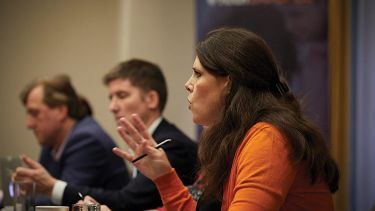
A VitalSource and Times Higher Education webinar explored how learning gain is progressing and who the measurement is really for
Learning Gain, the term applied to measuring the educational “distance travelled” by students, forms one of the central pillars of the teaching excellence framework and is currently under review across higher education. In October, Times Higher Education’s news editor, Chris Havergal, chaired a webinar that brought together sector leaders to discuss the measurement and its associated complexities.
Learning gain aims to put in place a practical methodological measurement of student progress and outcomes without losing sight of the philosophical purpose of higher education. It is complex, far-ranging and will be an important measure used by students when deciding which university to attend, as well as providing a tool for regulators and employers to assess the institutions that are delivering to standard and those that are falling short.
What does it mean?
The panellists began by defining what learning gain means to them. Claire Gray and Carole Sutton, of the University of Plymouth, said the pilot they ran at their institution was about assessing learning gain “as a core component of all student programmes, focused on research methods, knowledge, skills and employability”.
Vanessa Boddington, interim managing director at VitalSource, was interested in the student perspective within learning gain and the tools that can be applied to enhance students’ experience as they learn.
“To us, a key component of learning gain is about understanding and capturing the student experience. This will be critical in allowing institutions to deliver approaches that fully support students in their learning, across all levels of ability,” she said.
Overcoming challenges
The discussion moved on to the challenges faced in measuring learning gain and how they could be overcome. For Dr Gray and the Plymouth project, completion of the measurement had been the biggest consideration, with students reluctant to finish in-depth assessments of their educational gain.
Ms Boddington commented that technology can be a key enabler in helping to support and measure learning gain achievements.
Recent research carried out by VitalSource found that 66 per cent of students said that they study more effectively with education technology, while 50 per cent said that it was more likely to help them complete their course.
Fiona Harvey, head of digital education at the University College of Estate Management, a distance-learning platform, agreed with the idea that technology can be used to enhance learning gain projects. UCEM is currently trying to develop digital literacy skills and gather insight from students about engagement levels.
Platforms such as Pathbrite, which enables educators to create digital portfolios to help students reflect on what they are learning, have had an enduring benefit, Ms Harvey added.
What the students think
The discussion then addressed the student perspective, particularly their awareness of learning gain projects.
There were some disagreements among the panellists about the reasons for a lack of participation by some students.
Zachary Hardman, a recent graduate of the University of Cambridge, was introduced to the concept of learning gain through a 2017 National Student Survey, the results of which fed into the teaching excellence and student outcomes framework. The NSS was boycotted by a number of students’ unions over fears that it would lead to a rise in tuition fees.
Mr Hardman said that the boycott was the consequence of a “communications failure” and that advocates missed an opportunity to emphasise the central benefits that learning gain will deliver for students.
The challenges of bringing students on board were about positioning and ensuring that students see the value of participation, argued Dr Gray. She added that, in her view, an incentive-led approach would not be sustainable in the long term.
In Ms Harvey’s estimation, it was important that projects avoided excessive jargon and clearly laid out the benefits of learning gain as the sector attempts to develop a widely accepted definition of it.
Next steps
The webinar concluded with a discussion about where learning gain projects go from here. Dr Gray emphasised the necessity of “embedding” the principles of learning gain in an institutional context. She also cautioned against trying to include too much within the learning gain measurement.
For Ms Harvey, comparisons between institutions ought not to be the purpose of future projects. Using learning gain to create an aggregate or league table of universities would be “meaningless”, she said. Instead, learning gain should focus on using technology to personalise the learning experience.
In summary, Mr Havergal suggested that while practitioners did not appear to believe that learning gain was a comparative measure for wider use, policymakers might end up imposing metrics on the higher education sector if it did not offer up its own.
VitalSource improves learning outcomes and affordability at scale. For more information, visit get.vitalsource.com
Stream the webinar in full here.

